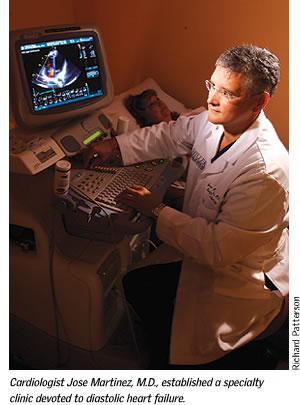 Most patients battling heart failure
have the same problem with their body’s most important
muscle: it just can’t contract like it once did.
Systolic heart failure accounts for as many as nine out
of ten cases of heart failure. Most patients battling heart failure
have the same problem with their body’s most important
muscle: it just can’t contract like it once did.
Systolic heart failure accounts for as many as nine out
of ten cases of heart failure.
But the remaining patients are in just
as much danger even if they don’t have the same classic symptoms, like
fatigue and shortness of breath.
That’s why UM cardiologist Jose Martinez, M.D., created
a specialty clinic dedicated to diastolic heart failure. “Systolic
is still more prevalent but diastolic is just as important,” says
-Martinez, who is an assistant professor of clinical medicine
at the Miller School of Medicine. “We’re raising
our awareness, and also data is showing that it carries
significant risk, just like systolic hypertension. It’s
not something that we can ignore.”
Systolic refers to the compression of
the ventricles to push out blood—it’s the higher first number
in a blood pressure reading. Diastolic refers to the atrium
refilling the ventricle with blood, like blowing up a balloon.
In diastolic dysfunction, the left ventricle
becomes stiff and inflexible, especially with age. The
left
atrium draws
in oxygenated blood from the lungs then pushes it into
the left ventricle, which then sends it out into the
body. If the ventricle is stiff, the atrium has to
work harder
to fill it. And if a patient with this problem has
high blood pressure, the left atrium must work harder
still.
“You don’t really lose systolic
function because your blood pressure is high,” says
Martinez. “You
don’t lose systolic function because you’re
under a lot of stress. These stressors are deadlier
with diastolic problems, and that’s when they’re
going to produce symptoms.”
Martinez and his colleagues have created
a specialty clinic for patients who they suspect have
diastolic
dysfunction. It offers patients access to physicians
with a growing
skill set for diagnosing and treating the disease
while helping teach doctors even more. |